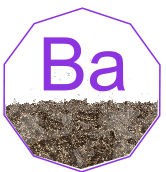Barium

Barium (Ba)
General Information
- Symbol: Ba
- Atomic Number: 56
- Atomic Weight: 137.327 u
- Element Category: Alkaline earth metal
- Group: 2
- Period: 6
- Block: s-block
Physical Properties
- Appearance: Silvery-white metallic
- Density: 3.62 g/cm³
- Melting Point: 727 °C (1341 °F)
- Boiling Point: 1897 °C (3447 °F)
- Phase at STP: Solid
- Electron Configuration: [Xe] 6s²
- Oxidation States: +2 (most common)
Chemical Properties
- Reactivity: Highly reactive, especially with water and air. Reacts with oxygen to form barium oxide (BaO).
- Compounds: Forms compounds such as barium sulfate (BaSO₄), barium chloride (BaCl₂), and barium nitrate (Ba(NO₃)₂).
Uses and Applications
- Medical Imaging: Barium sulfate is used in medical imaging of the gastrointestinal tract (barium swallow, barium enema).
- Industry: Used in drilling fluids for oil and gas wells due to its high density.
- Pyrotechnics: Barium compounds are used to produce green colors in fireworks.
- Glass Manufacturing: Used to increase the refractive index of optical glass.
- Electronics: Used in the production of certain types of ceramics and superconductors.
Occurrence and Extraction
- Natural Occurrence: Found primarily in the minerals barite (barium sulfate, BaSO₄) and witherite (barium carbonate, BaCO₃).
- Extraction: Extracted through mining and processed by reducing barium sulfate with carbon to produce barium sulfide (BaS), which can then be converted to other barium compounds.
Isotopes
- Stable Isotopes: Barium has seven stable isotopes: Barium-130, Barium-132, Barium-134, Barium-135, Barium-136, Barium-137, and Barium-138.
- Radioactive Isotopes: Barium-133 is used in scientific research and medical diagnostics.
Safety and Handling
- Hazards: Barium and its compounds, especially soluble salts, are toxic and can cause severe health issues if ingested or inhaled.
- Precautions: Handle with care using appropriate protective equipment, and ensure proper ventilation to avoid inhalation of dust or fumes.
History
- Discovery: Discovered by Carl Wilhelm Scheele in 1774.
- Name Origin: Derived from the Greek word “barys,” meaning heavy, due to the high density of barium minerals.
Additional Facts
- Crystal Structure: Body-centered cubic (bcc)
- Magnetic Properties: Diamagnetic
- Thermal Conductivity: Moderate, about 18.4 W/m·K
- Electrical Resistivity: About 332 nΩ·m at room temperature
Summary
Barium is a highly reactive alkaline earth metal known for its use in medical imaging, industry, pyrotechnics, glass manufacturing, and electronics. It is found primarily in the minerals barite and witherite and is extracted through mining and chemical processing. Barium is highly toxic, especially in its soluble forms, and must be handled with care.
40 Question and Answer Pairs About Barium
What is the atomic number of Barium?
- 56
What is the symbol for Barium?
- Ba
What is the atomic weight of Barium?
- 137.327 u
In which group of the periodic table is Barium found?
- Group 2
What period is Barium in?
- Period 6
What block does Barium belong to?
- s-block
What is the melting point of Barium?
- 727 °C (1341 °F)
What is the boiling point of Barium?
- 1897 °C (3447 °F)
What is the density of Barium?
- 3.62 g/cm³
What is the electron configuration of Barium?
- [Xe] 6s²
What is the common oxidation state of Barium?
- +2
What is the appearance of Barium?
- Silvery-white metallic
Is Barium reactive with air?
- Yes, it reacts with oxygen to form barium oxide (BaO).
Name a compound of Barium.
- Barium sulfate (BaSO₄)
What is a common use of Barium sulfate in medicine?
- Used in medical imaging of the gastrointestinal tract.
How is Barium used in the oil and gas industry?
- In drilling fluids due to its high density.
What role does Barium play in pyrotechnics?
- Used to produce green colors in fireworks.
How is Barium used in glass manufacturing?
- To increase the refractive index of optical glass.
What application does Barium have in electronics?
- Used in the production of certain types of ceramics and superconductors.
Name a mineral that contains Barium.
- Barite (barium sulfate, BaSO₄)
How is Barium extracted from its ores?
- By reducing barium sulfate with carbon to produce barium sulfide, which can then be converted to other compounds.
What is the most stable isotope of Barium?
- Barium-138
Name a radioactive isotope of Barium used in medical diagnostics.
- Barium-133
What safety hazard is associated with Barium?
- Barium and its compounds are toxic if ingested or inhaled.
How should Barium be handled?
- With care, using appropriate protective equipment and ensuring proper ventilation.
Who discovered Barium?
- Carl Wilhelm Scheele
Where does the name Barium come from?
- From the Greek word “barys,” meaning heavy.
What is the crystal structure of Barium?
- Body-centered cubic (bcc)
Is Barium paramagnetic or diamagnetic?
- Diamagnetic
What is the thermal conductivity of Barium?
- About 18.4 W/m·K
What is the electrical resistivity of Barium at room temperature?
- About 332 nΩ·m
What is the primary oxidation state of Barium?
- +2
Is Barium found as a free element in nature?
- No, it is found in minerals like barite and witherite.
What is the common name of barium chloride?
- BaCl₂
What is a major application of barium nitrate (Ba(NO₃)₂)?
- Used in pyrotechnics to produce green colors.
How does Barium benefit medical imaging?
- Barium sulfate is opaque to X-rays, allowing for clear imaging of the gastrointestinal tract.
What is the boiling point of Barium in Kelvin?
- 2170 K
What group does Barium belong to in the periodic table?
- Alkaline earth metals
What is the natural abundance of Barium-138?
- About 71.7%
Can Barium be used in high-temperature applications?
- Yes, in specific industrial and electronic applications.






